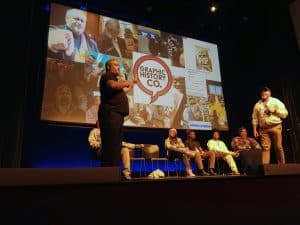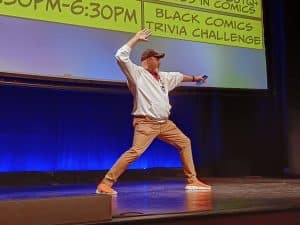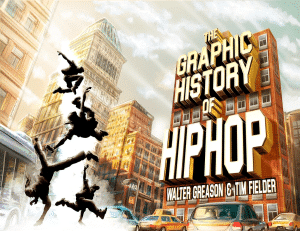
This past weekend The Schomburg Center for Research in Black Culture in New York City hosted its 12th Annual Black Comic Book Festival. This event is a gathering and celebration of Black creators, their works, and the fans that support them. It was also the perfect opportunity to talk with the creative team of the new graphic novel The Graphic History of Hip Hop by writer Dr. Walter Greason and artist Tim Fielder and interview them about their new project.

The duo were on the first panel of the day Graphic Histories and Black Comics in the Classroom, where they talked briefly about the book, its origin, and the next phases. Watching the two of them is a hoot, you would think that they could take this on the road, but they’ve already done that traveling the country to promote the book.
Following the panel Fielder jumped into his kids of all ages workshop on How to Draw, eventually, I was able to catch up with them to chat about their book.

George Carmona 3rd: Gentlemen first, could you give us a little bit of your history and how you got into comics?

Walter Greason: I’m a professor of history at St. Paul, Minnesota at Macalester College. For comics, I started reading comics when I was a very, very small child, it’s how I developed my passion to read. The particular piece of using comics for education grew out of my early years teaching middle and high school. And so this is a culmination of many, many years of work, and it’s the finest educational tool I’ve ever made.

Tim Fielder: I am a visual Afro-futurist and graphic novelist. I’ve been in comics on and off since 1987. I love comics, comics have always been a part of my life, and coming to this particular point with The Graphic History of Hip Hop and being associated with Dr. Walter Grayson when he graciously asked me to be a part of this project has undeniably altered the course and the direction of my career and my life. It is easily the biggest book I’ve ever done so far and the opportunities that have come up just within the last two minutes.
Carmona: You talked about coming from an educational background. With this project, what do you want people to glean from it in terms of history? It’s not just a paint-by-numbers history book, right with the History of Hip Hop. How do you want people to use it as an educational tool, beyond the music aspect of it?
Greason: You’re absolutely right. It is not a paint-by-numbers text, there are layers on top of layers of meaning, character, and sacrifice that are built into each page and every panel. You can study it for years and never stop finding all of the easter eggs and hidden meanings and the way that it all fits together. For me as an educator, that’s the key to growing people’s curiosity about a subject and we tap into something people feel familiar with. They all have memories of Hip Hop, songs they love, and artists they appreciate, in ways that it’s kind of marked moments in their lives. People use Hip Hop songs for weddings, funerals, and the births of their children. In this piece of Hip Hop, what I’m able to do is place it in a larger historical context. People see their lives in a different light, but at the same time, it feels intimate and familiar. And doing that, playing into the genius of Tim Fielder’s art, the way people connect with their artists in a deep and intimate way as they look at each page, it’s just a beautiful experience, and it’s what makes the readers all respond so positively. It’s that this isn’t just my voice or Tim’s, it’s their own voices that are being affirmed as a result.
Carmona: Tim, you’re not a full-on teacher but you do work to educate people in drawing, like today’s drawing class, which you did a great job of inspiring people. I remember years ago, you were doing a panel here and telling people, it doesn’t matter how you do it, all you need to do is just do it, and the results will come. Are there any other lessons you can give that tie in with the book that you want to share with people?
Fielder: Oh yeah, doing this book, actually I almost hurt myself pretty badly. And what I’ve learned the general lesson I always tell folks is finishing activates opportunity, when you finish something, it allows you to access, through those finishing opportunities that would not be accessible if you did not finish, right? So what I would say now is that in the process of completing the labor, that is necessary to finish the project, it is essential that you take care of yourself physically because we are athletes, anyone that’s in this job whether it be comics or journalism for us, you know, it’s not something as concrete as sports, but it is a cerebral, physical activity that requires and demands hours of time at the tables, studying, honing your craft. It demands that you treat your body like a car, you have to get maintenance on it. You have to take care of it. This is something that I’m learning, what happens when you don’t do that. But I’m also finding that the mental component of producing this work, particularly with the number of operators in the Hip Hop sphere is so daunting, I think I must have painted over 200 hundred operators. And of course news alert, now we’re scheduled for Volume Two and Three, we are now contracted to do for the Department of Education, which we have to turn in towards the end of June, which of course will result later on in expanded editions for the Graphic History Company, which is the company that Walter and I founded to produce graphic histories. So treat yourself well, treat yourself as a machine, as a business, forgive yourself, and finally, it is so important to not ride yourself so hard, which is one of the things I was doing because I’m so dead set on finishing this for delivery as promised.
Carmona: They don’t call ‘em deadlines for nothing.
Fielder: Yes, but then the operative word is dead. That’s the thing, sometimes you’ve got to ease up. That’s what I’ve learned.

Carmona: We’ve talked in general, let’s talk about the book itself, the history in that. How did you guys come to this project, was it something you pitched to them? Or did they come to you? What’s the genesis of The Graphic History of Hip Hop, besides actual Hip Hop?
Greason: This particular project started really two years before I made the call to Tim. I was working with the New York City Department of Education, also called the New York City public schools, and writing for them opened up exactly what Tim says finishing creates opportunity. They saw in late 2022, that their series of comics were doing well, they expected that if they could do something to celebrate the 50th anniversary of Hip Hop in 2023, that would also do very well. And so the staff and Joe Schmidt came to me and asked did I have an artist in mind, having seen Tim’s work over the previous seven years and been inspired and amazed by his skill and reliability reached out, gave him a call and then that’s when it really all came together was when he said yes, he had the time to do it.
Fielder: Yeah, I would say piggybacking off of what Walter just said, I appreciate that, but what I found that is more constant than reliability is certainty. It’s like I broke so many deadlines. But what I had to constantly tell myself and to inform Walter was that you can be certain that I will finish this book. And I have found that having that attitude you know, putting the health issues aside, always guarantees that the work will have at least a high level of quality, that we will have a book that we are proud of. I think that no book is ever monolithically, you know, praised, but we have been very fortunate, you know, people love the way the book looks. I think because of that. This is gonna perhaps sound a little capitalist but the book sells itself. Do you know what I mean? When it looks a certain way, it’s guaranteed to attract readers,
Carmona: A quality product.
Fielder: The reality is that indeed, when you produce a superior product, as imperfect as it is, it does seem dramatically easier to do your job.
Carmona: And that kind of goes into the book itself. When readers get to the book, what should they expect to see? You spoke a little bit about it earlier but for readers that will only see some sample pages, will they be able to enjoy the book without knowing all of the history of Hip Hop? Will this be that introduction? Will that help them say let me go back and listen to the Sugar Hill Gang and all the rest of them cats?
Greason: Absolutely. So panel by panel, it’s a different experience, but they all come together like a mosaic, and by the time you hit the end, you see the whole portrait. And what I’m seeing from some of the readers that come back and talk to me as they’ve seen different pieces of it it’s almost like if someone saw The Wire, all five years of that show about Baltimore, and at the end of the series, you have this main character who has all these flashbacks. He’s looking out over a bridge and he thinks all the way back to season one and you get all these elements in these moments that are all accumulated that made the experience extraordinary. And that’s what some of the readers really dive in and take their time with all of it. That’s what they’re coming back with is like this, this appreciation of the last 50 years and this grounding of having a clearer sense of themselves in their world.
Fielder: Also, I’d add that one of the things that I as an individual operator of just creating visuals, was to make sure that I’m embedded within the visual narrative, lots of heart. Because the Graphic History of Hip Hop, the way it’s written, the way it’s drawn, the way it produces that dance between the visual and the words. It’s all about sentimentality and historical accuracy. But can it ever really be completely accurate because the story of Hip Hop is totally from a billion different perspectives and those perspectives I’m sad and also elated to say, are endless.
Greason: No, it’s comprehensive, it’s not complete.
Fielder: That’s right. It can’t ever be complete.
Greason: Exactly right. We just contributed to the central piece, to the larger understanding.
Fielder: There it is.
Carmona: I just started reading a book about a person who read all of Marvel’s comics and he’s using the reading device so that he can associate certain things with eras to push them along to create a narrative of reading stories instead of regurgitating what he read, creating his own narrative with that. So here’s the real tough one. It’s going to be the controversial part, what would be your top five artists or if you want to do songs, what would be your top five songs, artists groups?
Fielder: That’s easy, Bring the Noise (Public Enemy), Erik B and Rakim Follow the Leader. Pete Rock & CL Smoove, T.R.O.Y. Okay. I’m going to say, it’s going to be terrible, Baby Got Back, I’m so sorry. That song moved the planet Earth, I don’t care how much they get on Sir Mix A Lot and I’m just talking about the song. And then the last one, I am a huge, huge fan of Mos Def, I think that man’s brilliant.
Carmona: But is there a particular song?
Fielder: Yeah, but there are just a bunch of different albums, particularly the ones he produced obviously in the mid-2000s or early 2000s, I just think they’re phenomenal.
Greason: Yeah, for me, I’m gonna go a little different. I’m gonna start much more recently with Immortal Technique, and a song called Rich Man’s World. Just emblematic for deconstructing the era we’re living in right now and understanding the way greed destroys the human soul. Then I’ll go back to my early days, and I will say, Run DMC probably say Daryl and Joe like really gave me a whole appreciation of the use of the turntable and it makes me miss Jam Master J, just all the time. Then I’ll jump into the middle. I love that Lauryn Hill has just been recognized as a Hall of Fame artist by the recording industry. Her take on Stevie Wonder‘s Everything Is Everything is my favorite from her. And then I go forward a little bit, it’s going to be Pharoahe Monch Trilogy. One of the most complex and diabolical, lyrical, and musical arrangements where he tells three stories, three stories that are the same story from different perspectives. Just a genius and then I’ll bounce back a little further and go with my people from Philly, The Roots and so I’ll go The Roots 100% Dundee, which is also a nod to the Wu-Tang Clan at the same time like that moment in the mid-90s was just golden.
Carmona: All right, you gentlemen have your new company the Graphic History Company, I know you can’t talk about certain things coming up outside of the two books you’ve got going that are due soon, but is there anything else you want to talk about? Any individual projects you might be working on?

Greason: So on my end, I can’t do any more of these interviews and not start by mentioning a book called Illmatic Consequences that I did with Danian Darrell Jerry on Universal Write Publications a year ago, that really laid the foundation for how I thought about combining images with words and actually combating the current moment were they condemn critical race theory where they condemn diversity, equity, and inclusion. And so that’s essential. On top of that, I would say, right now I’m working with the state of New Jersey on its first-ever reparations plan. And working with editor William Darity at Duke, on his book Black Reparations Project, you can look for that at the end of this year, come out to the community forum, and share your ideas about the debt owed from slavery and segregation by the state of New Jersey. And then I would say the digital humanities project called Shifting Landscapes out of New Orleans. We took a historic plantation owner’s mansion, the Gallier House and I’ve turned it into a digital exhibit where we explore the lives of the people that were enslaved there and talk about their day to day experiences, the newest addition of that digital website will be up and running in October.
Fielder: Also, I want to add, Matty’s Rocket 2 is on the way so relax.
The Graphic History of Hip Hop is out now in both hard and soft cover.





